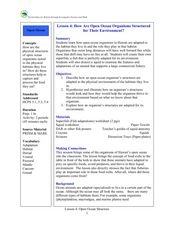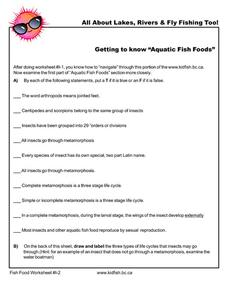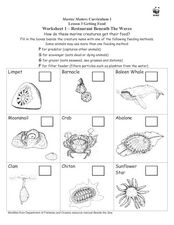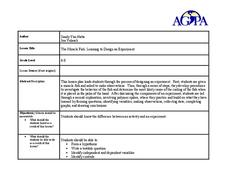Curated OER
How Are Open Ocean Organisms Structured for Their Environment?
Students explore biology by conducting an animal dissection. In this oceanography lesson plan, students identify the life cycle of a squid and other animals that are involved with commercial fishing. Students dissect a squid in class and...
Curated OER
Getting to Know "Aquatic Fish Foods"
In this fish instructional activity, students access a website to learn more about the common insects eaten by fish. Then students draw and label three types of insect life cycles. This instructional activity has 10 true or false...
Curated OER
Toothpick Fish
Students experiment with genes and environment for a population of "Toothpick Fish."
Curated OER
Fisheries Project
Students explore biology by completing a fishing worksheet. In this commercial fishery lesson, students identify the process of taking mass fish from the ocean and delivering them to eateries while discussing the negative aspects....
Curated OER
Restaurant Beneath the Waves
In this marine life worksheet, students fill in the boxes beside each ocean creature name with one of the following feeding methods: predator, scavenger, grazer, and filter feeder. Students then list or draw marine creatures that use the...
Curated OER
Oxygen-Carbon Dioxide Cycle
Fifth graders observe a diagram of the oxygen-carbon dioxide cycle to know that when they breathe out, they exhale carbon dioxide as do animals. They observe an aquarium containing both plants and fish and discuss the cycle. They then...
Curated OER
Fishes and Amphibians
For this fish and amphibian characteristics worksheet, students will two idea maps to compare fishes and amphibians. Students will complete 2 short answer questions based on these idea maps.
Sea World
Ocean Discovery
Immerse your young marine biologists in the world of marine animals. The lesson includes several activities that are age-appropriate for preschoolers and kindergartners, including coloring pages, gluing feathers and sand onto paper...
Curated OER
Fred the Fish -- A River Ran Wild
Students apply cause and effect relationships to water pollution in a stream. In this pollution activity students recognize the importance of clean water in their daily lives. Students accompany "Fred the Fish" as he travels down stream....
Curated OER
Phylogeny
Here is an unusual collection of slides. The first, which is upside down, is the phylogeny of fish. Next comes an article about invasive lampreys in the Great Lakes area. The third slide shows the life cycle of sea lampreys. A reptilian...
Curated OER
Designing for Salmon and Steelhead
Sixth graders create designs for salmon habitats. They work in groups to design a tank habitat that mimics the requirements for salmon in various phases of its life cycle. Students may also raise salmon eggs as part of this unit.
Curated OER
Salmon Scavenger Hunt
Learners go on a salmon scavenger hunt to find out about threats to salmon populations. They gather information about some of the reasons wild salmon have gone from such incredible abundance to relative scarcity, and about some of the...
Curated OER
Tadpole Diary
Second graders examine the life cycle by observing tadpoles. After reading the book, Tadpole Diary, they draw the stages of tadpole development and write sentences about what they think is happening.
Curated OER
Fly Tying
Young scholars practice fly tying and explain water conservation efforts in Iowa. In this ecology, Iowa geography, and natural resources lesson, students identify basic equipment and material needed to fish, then tie flies. Young...
University of Southern California
Mastering Microbes
Small but mighty! Learners explore the role of microbes in a healthy ecosystem. An engaging lesson asks pupils to design an aquaponics system that demonstrates that healthy microbes are necessary to maintain the ecosystem.
Curated OER
Salmon and Steelhead Life Stories Web Search
Students conduct an Internet investigation to discover the natural history of local salmon and/or steelhead. They then write a story that describes the life of a salmon or steelhead from the local creek, including a description of each...
Curated OER
The Miracle Fish: Learning to Design an Experiment
Young scholars develop procedures to explore the behavior of fish. In this scientific experiment lesson students from a hypothesis, write a question, identify different variables and controls in their experiment.
Curated OER
Adaptable Mandibles
Learners define adaptation and highlight example of adaptation in birds and other animals. They study feeding techniques of seabirds and investigate the effect that trash has on wildlife.
Curated OER
Web of Life Game: Trout
Students explore the concept of food webs. In this food web lesson, students demonstarte the connection between species. Students use a ball of string show how the food web works, then have a class discussion.
Biology Junction
Cnidarians
In this cnidarian worksheet, learners study the biology of the different species of cnidarians and complete a series of questions.
Curated OER
Swimming With the Crabs!
In this environmental science activity, students complete a graphic organizer (Frayer model) on blue crabs. They write an article using the given facts.
Biology Junction
Cnidarians and Ctenophorans
Cnidaria is a broad phylum of 11,000 different species from jellyfish to coral. Most Cnidarians are marine species with a few freshwater examples. A lesson presentation explains the important characteristics of different species of both...
Curated OER
Elementary Animal Classification
Students investigate eight basic animal groups, and identify the different groups through knowledge of animal characteristics, changes, and life cycles of each group.
Biology Junction
Introduction to Animals
Out of all animals, elephants alone lack the ability to jump. Scholars learn all about animals using a presentation full of fun examples. It describes different types of animals, the biological similarities and differences between...
Other popular searches
- Lion Fish Life Cycle
- Gold Fish Life Cycle
- Butterfly Fish Life Cycle
- Life Cycle of a Fish
- Jelly Fish Life Cycle
- Fish Life Cycle Goldfish
- Ocean Fish Life Cycle
- Fish Life Cycle Terminology
- Trigger Fish Life Cycle
- Blow Fish Life Cycle
- Life Cycle of Fish
- Life Cycle Fish

























